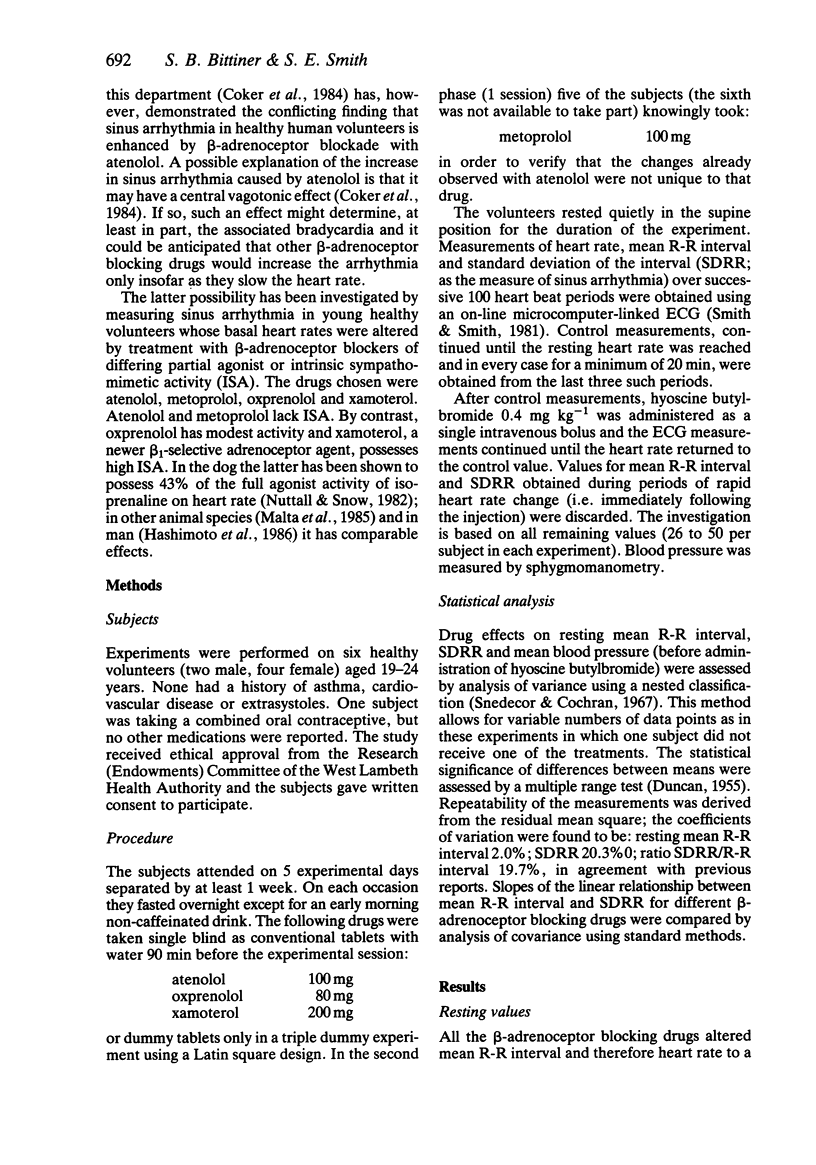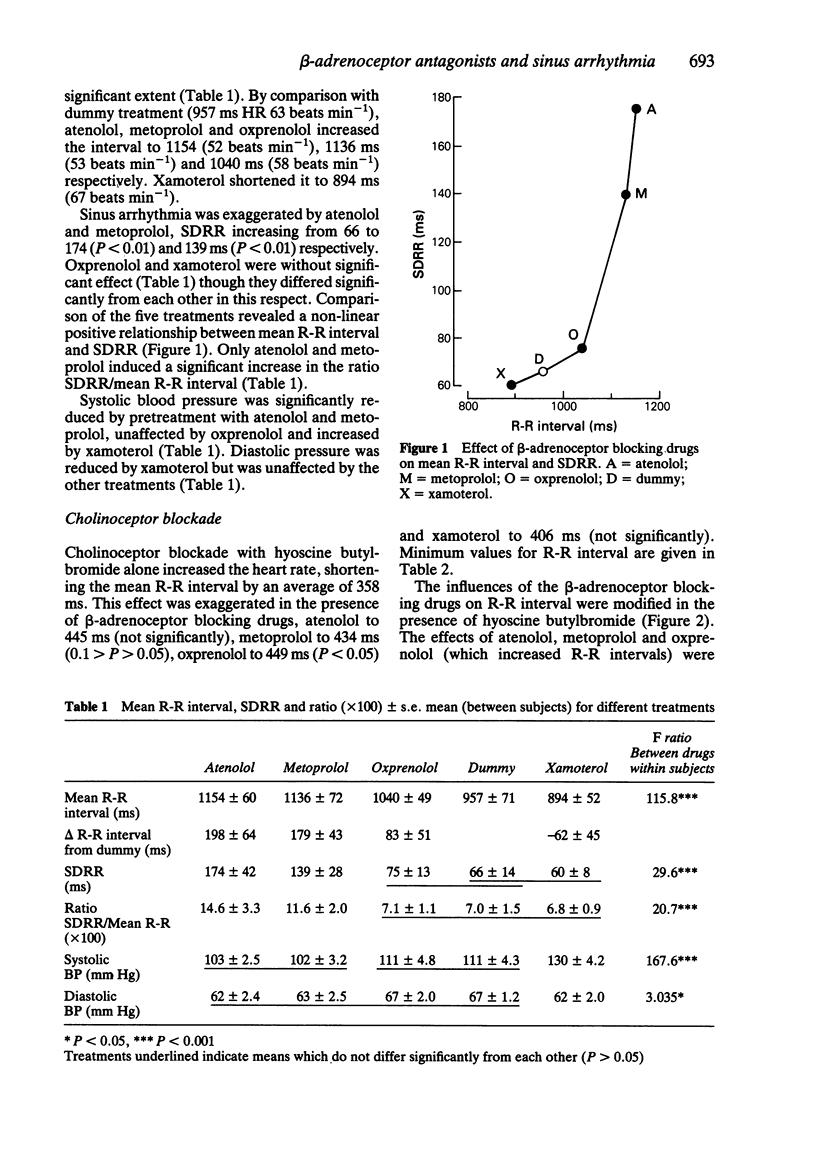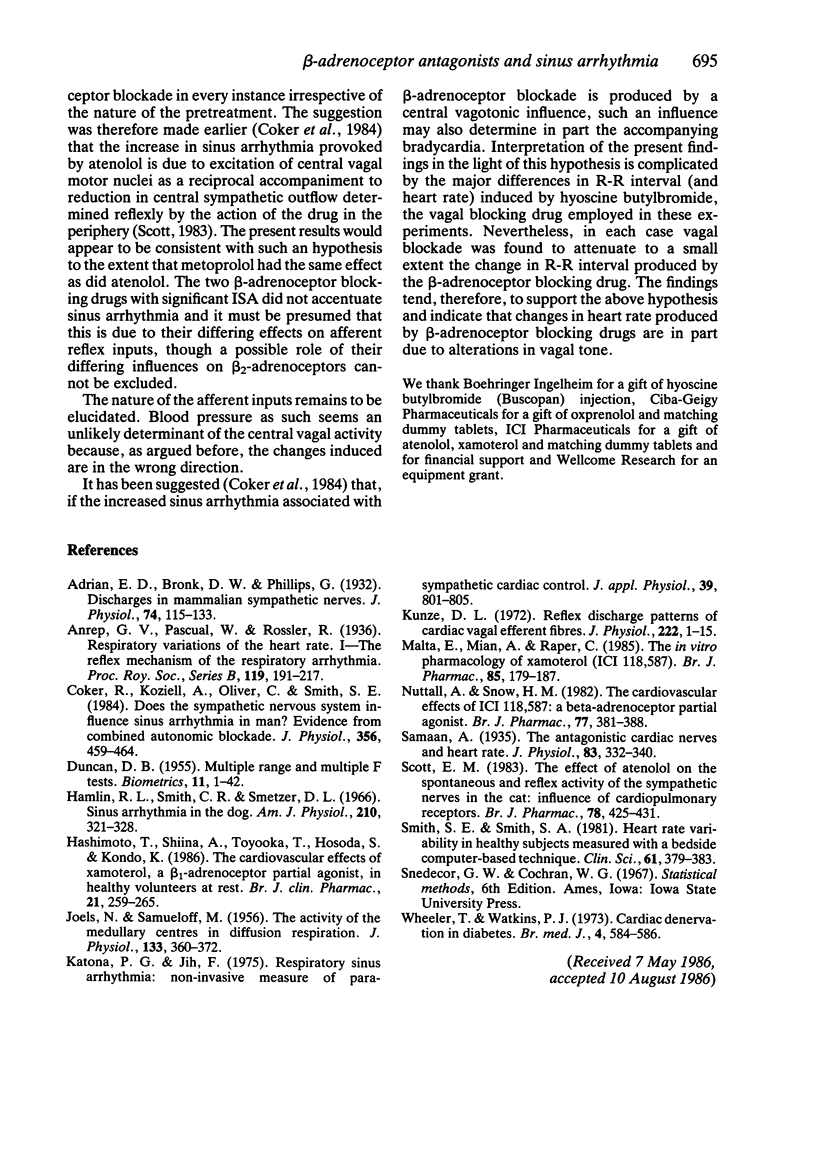Abstract
The influence of vagal and sympathetic efferent activity on sinus arrhythmia in man has been studied in six healthy subjects by administration of hyoscine butylbromide and/or various beta-adrenoceptor blocking drugs using a microcomputer-linked electrocardiogram system. Sinus arrhythmia was quantitated as the s.d. of the R-R interval. Sinus arrhythmia was almost abolished by hyoscine butylbromide irrespective of the absence or presence and nature of the beta-adrenoceptor blocking drug. Atenolol and metoprolol alone prolonged the mean R-R interval and increased sinus arrhythmia. Oxprenolol, a drug with modest partial agonist or intrinsic sympathomimetic activity (ISA), prolonged the mean R-R interval to a lesser extent but had no effect on sinus arrhythmia. Xamoterol, which has high ISA, shortened the mean R-R interval but had no effect on sinus arrhythmia. These data yielded a non-linear relationship between sinus arrhythmia and mean R-R interval. Exaggerated sinus arrhythmia appears to accompany beta-adrenoceptor blockade only in the absence of ISA when bradycardia ensues. These findings are consistent with the hypothesis that the exaggeration in sinus arrhythmia is due to a central vagotonic effect secondary to the action of the drugs in the periphery. Changes in R-R interval induced by the adrenoceptor blocking drugs were altered to some extent by vagal blockade. This observation is consistent with the hypothesis that changes in heart rate induced by such drugs are determined in part by a change in vagal tone.
Full text
PDF




Selected References
These references are in PubMed. This may not be the complete list of references from this article.
- Adrian E. D., Bronk D. W., Phillips G. Discharges in mammalian sympathetic nerves. J Physiol. 1932 Feb 8;74(2):115–133. doi: 10.1113/jphysiol.1932.sp002832. [DOI] [PMC free article] [PubMed] [Google Scholar]
- Coker R., Koziell A., Oliver C., Smith S. E. Does the sympathetic nervous system influence sinus arrhythmia in man? Evidence from combined autonomic blockade. J Physiol. 1984 Nov;356:459–464. doi: 10.1113/jphysiol.1984.sp015476. [DOI] [PMC free article] [PubMed] [Google Scholar]
- Hamlin R. L., Smith C. R., Smetzer D. L. Sinus arrhythmia in the dog. Am J Physiol. 1966 Feb;210(2):321–328. doi: 10.1152/ajplegacy.1966.210.2.321. [DOI] [PubMed] [Google Scholar]
- Hashimoto T., Shiina A., Toyo-Oka T., Hosoda S., Kondo K. The cardiovascular effects of xamoterol, a beta 1-adrenoceptor partial agonist, in healthy volunteers at rest. Br J Clin Pharmacol. 1986 Mar;21(3):259–265. doi: 10.1111/j.1365-2125.1986.tb05188.x. [DOI] [PMC free article] [PubMed] [Google Scholar]
- JOELS N., SAMUELOFF M. The activity of the medullary centres in diffusion respiration. J Physiol. 1956 Aug 28;133(2):360–372. doi: 10.1113/jphysiol.1956.sp005592. [DOI] [PMC free article] [PubMed] [Google Scholar]
- Katona P. G., Jih F. Respiratory sinus arrhythmia: noninvasive measure of parasympathetic cardiac control. J Appl Physiol. 1975 Nov;39(5):801–805. doi: 10.1152/jappl.1975.39.5.801. [DOI] [PubMed] [Google Scholar]
- Kunze D. L. Reflex discharge patterns of cardiac vagal efferent fibres. J Physiol. 1972 Apr;222(1):1–15. doi: 10.1113/jphysiol.1972.sp009784. [DOI] [PMC free article] [PubMed] [Google Scholar]
- Malta E., Mian M. A., Raper C. The in vitro pharmacology of xamoterol (ICI 118,587). Br J Pharmacol. 1985 May;85(1):179–187. doi: 10.1111/j.1476-5381.1985.tb08845.x. [DOI] [PMC free article] [PubMed] [Google Scholar]
- Nuttall A., Snow H. M. The cardiovascular effects of ICI 118,587: A beta 1-adrenoceptor partial agonist. Br J Pharmacol. 1982 Oct;77(2):381–388. doi: 10.1111/j.1476-5381.1982.tb09309.x. [DOI] [PMC free article] [PubMed] [Google Scholar]
- Samaan A. The antagonistic cardiac nerves and heart rate. J Physiol. 1935 Feb 9;83(3):332–340. doi: 10.1113/jphysiol.1935.sp003232. [DOI] [PMC free article] [PubMed] [Google Scholar]
- Scott E. M. The effect of atenolol on the spontaneous and reflex activity of the sympathetic nerves in the cat: influence of cardiopulmonary receptors. Br J Pharmacol. 1983 Feb;78(2):425–431. doi: 10.1111/j.1476-5381.1983.tb09407.x. [DOI] [PMC free article] [PubMed] [Google Scholar]
- Smith S. E., Smith S. A. Heart rate variability in healthy subjects measured with a bedside computer-based technique. Clin Sci (Lond) 1981 Oct;61(4):379–383. doi: 10.1042/cs0610379. [DOI] [PubMed] [Google Scholar]
- Wheeler T., Watkins P. J. Cardiac denervation in diabetes. Br Med J. 1973 Dec 8;4(5892):584–586. doi: 10.1136/bmj.4.5892.584. [DOI] [PMC free article] [PubMed] [Google Scholar]


